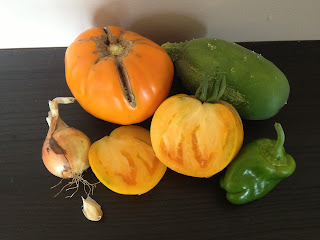We have a lot, especially this time of year, when there are literally (literal literally, not figurative literally ) piles of tomatoes and cucumbers in the kitchen waiting for us to preserve them, plus lots of other fruits and veggies. That kind of bounty allows us to eat really well. To wit, yesterday's lunch: That's a ploughman's plate of strawberries, crackers, mustard, cheddar, blue cheese, pickled beets , sweet gherkins , and a curry sour spear . And then dinner: Cucumber and tomato salad dressed with pickled beets and onions, sage-roasted potatoes (first of the fall harvest! freshly dug yesterday!), and Swedish meatballs with gravy. Yum, yum, yum. Because we have so much, we are now in a position to give a bunch away. We love giving baskets to friends who appreciate produce, and bartering tomatillos for sausage buns at the Buttermilk Bakery yesterday was awesome. But we were psyched today to make up a couple grocery bags of ...














